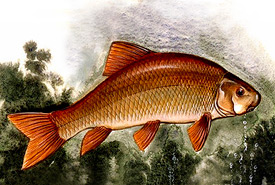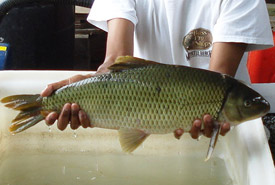Something's Fishy: Redheads unite

Copper redhorse (Illustration by Jan Sovak, 1989)
Growing up, I hated my hair colour. I was teased relentlessly, often wishing I was more like my light-haired classmates and the kids lucky enough to be born brunettes. My mother would tell me how fortunate I was to be different, but as a kid the last thing you want is to stand out from the crowd. As soon as I entered high school, I hit the salon, dying my hair dark and as far away from my natural red as possible. There was nothing I wanted more than to be like everyone else, until I realized (as my mother predicted) that being a redhead was my birthright — one that I eventually swam back to.
According to studies, redheads are a dwindling breed, and we might have climate change to blame for it. But we’re not the only ginger species fearing extinction due, in part, to a warming environment.
Copper redhorse is a freshwater fish that lives in shallow grass-beds in the St. Lawrence River. Unlike red-haired humans around the world, and with the highest concentration found in Scotland and Ireland, the copper redhorse is endemic to Canada and found nowhere else on the planet.
The species’ population size is uncertain, but scientists estimate that only a few hundred individuals remain in Canadian waters. The Committee on the Status of Endangered Wildlife in Canada, the IUCN Red List and the Species at Risk Act list copper redhorse as endangered. The fish is vulnerable to habitat fragmentation and loss, pollution and invasive species. The species also tends to spawn later in the season, making its newly hatched young susceptible to lower water levels. Studies carried out since the early 1990s show that the copper redhorse's natural reproduction cycle is often disrupted due to pollution from agricultural and urban runoff.

Copper redhorse (Photo by NCC)
The copper redhorse is the largest sub-species of redhorse in Quebec and it also lives the longest, averaging around 30 years of age in the wild. This resilient copper fish also has quite the bite. It feeds mainly on snails and has robust teeth to chomp through the shells of its prey.
Much like my mother, organizations and governments see the value in protecting redheaded species. The Nature Conservancy of Canada (NCC) works to protect habitat for this species by conserving the islands and surrounding waters it is known to inhabit. NCC also protects 15 kilometres of riverbed in the Richelieu River and Île Jeannotte and Île aux Cerfs archipelago, which together equal more than 70 acres (30 hectares) of important habitat for young copper redhorse.
NCC actively works with the Ministry of Sustainable Development, Environment and Parks in Quebec to keep this species safe. To remedy the habitat loss, NCC launched a campaign in 2006 to naturalize the riverbanks along the Richelieu River. The campaign, which involves numerous stewardship projects to keep waters clean for the species, still runs strong to this day.
It’s time to see the value of redheads, both those walking on land and those swimming in water. I’ve finally come into my own as a redhead and wear the ginger title proudly. I stand united with this copper fish as a redhead and a conservationist, forming a bond with this species no bottle of dye could ever conceal.
Something’s Fishy is a monthly series written by NCC’s Editorial Coordinator, Raechel Bonomo, highlighting a species or group of fish that inhabit Canadian waters.


